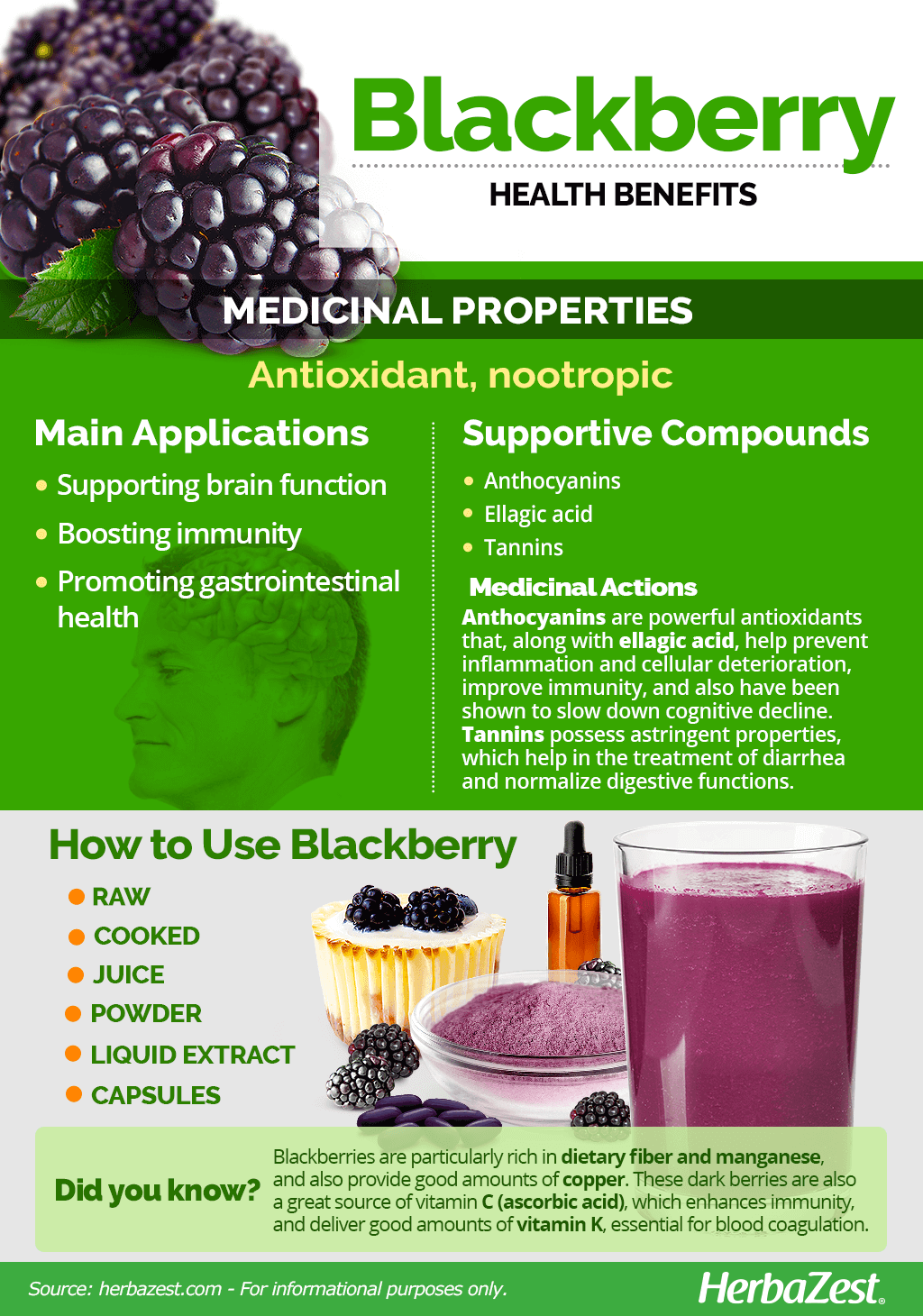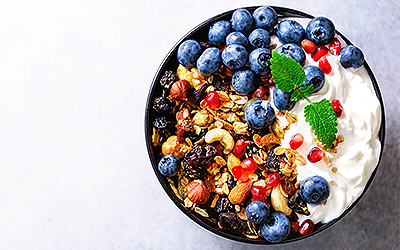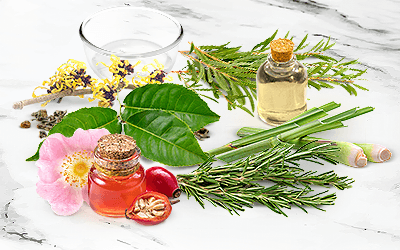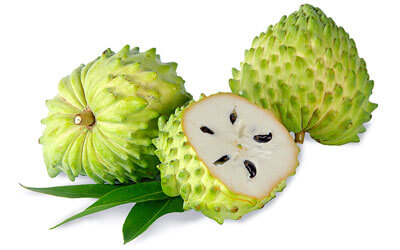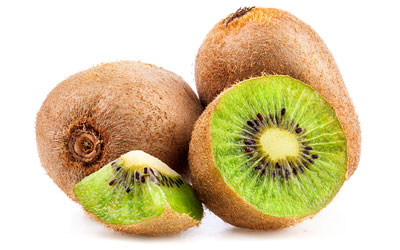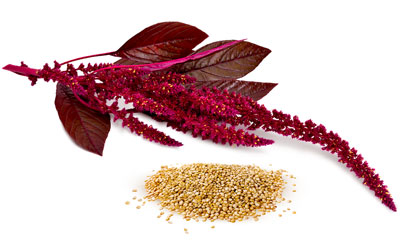The blackberry fruit, also known as bramble or brambleberry, has been valued since ancient times for both its culinary and medicinal properties. Because blackberries grow wildly throughout the world, they have retained their popularity in many different cultures.
Blackberry Medicinal Properties
Health Benefits of Blackberry
Because blackberry is more widely used as a food product, there are very few studies about this fruit. Nonetheless, the following potential medicinal uses have been suggested for blackberry properties:
Supporting brain function. Thanks to their antioxidant properties, blackberries boost memory and cognition, thus preventing age-related diseases, such as dementia and Alzheimer.
Boosting immunity. Blackberries strengthen cell metabolism, which shields the body against damaging free radicals and potentially harmful pathogens.
Promoting gastrointestinal health. The consumption of blackberries encourages good bacterial growth, which helps with the treatment of diarrhea and improves digestion.
Additionally, blackberries are a good source of fiber, which helps naturally regulate blood sugar.
How It Works
The health benefits of blackberries hail from an abundance of phenolic compounds, mainly anthocyanin, a powerful antioxidant, which is responsible for the fruit's dark hue, and ellagic acid, which helps prevent inflammation and cellular deterioration.
Both of these antioxidant compounds work by reducing the proliferation of reactive oxygen species in cells, thus preventing mutations and death due to oxidative stress. This mechanism of action not only improves immune responses against diseases, but has also shown to have neuroprotective effects.
In addition, the presence of tannins allows for the astringent properties of blackberries, which help in the treatment of diarrhea and normalize digestive functions.
Acai and blueberry also possess antioxidant properties, whereas tomato and pineapple provide similar anti-inflammatory benefits.
Side Effects of Blackberry
Blackberry is considered generally safe for consumption; however, it may trigger unfavorable reactions in people allergic to Rosaceae species, causing anaphylaxis in rare cases.
Overconsumption of blackberry may cause adverse reactions, such as stomach discomfort, nausea, and vomiting.
Cautions
While the tannins in blackberry are considered harmless in dietary amounts, people with history of degenerative diseases, such as cancer, as well as the ones with chronic gastrointestinal conditions should seek the advice of a health care professional before consuming the leaves and roots of blackberry in medicinal doses.
Blackberry fruits are considered safe for everyone to consume; however, women who are pregnant and breastfeeding as well as children under two years old should avoid blackberry leaf tea.
- Medicinal action Antioxidant, Nootropic
- Key constituents Anthocyanins, ellagic acid, tannins
- Ways to use Capsules, Liquid extracts, Food, Freshly ground, Juiced, Powder
- Medicinal rating (3) Reasonably useful plant
- Safety ranking Safe

Blackberry Nutrition
Blackberries are particularly rich in dietary fiber and manganese, an essential mineral that helps with the formation of bones and connective tissue as well as with blood clotting and the functioning of the endocrine system.
They also provide good amounts of copper, which works with iron to help produce red blood cells as well as promote the health of blood vessels, nerves, immune system, and bones.
As other berries, the blackberry fruit is a great source of vitamin C (ascorbic acid), which enhances immunity, thus shielding the human body against harmful pathogens and degenerative diseases.
It also provides good amounts of vitamin K, which is necessary for proper coagulation, and smaller quantities of many other nutrients, including vitamins E, folate, and most members of the B-complex group, along with minerals like zinc and magnesium.
100 grams of fresh blackberries provide 43 calories and 21% of the recommended daily value for dietary fiber.
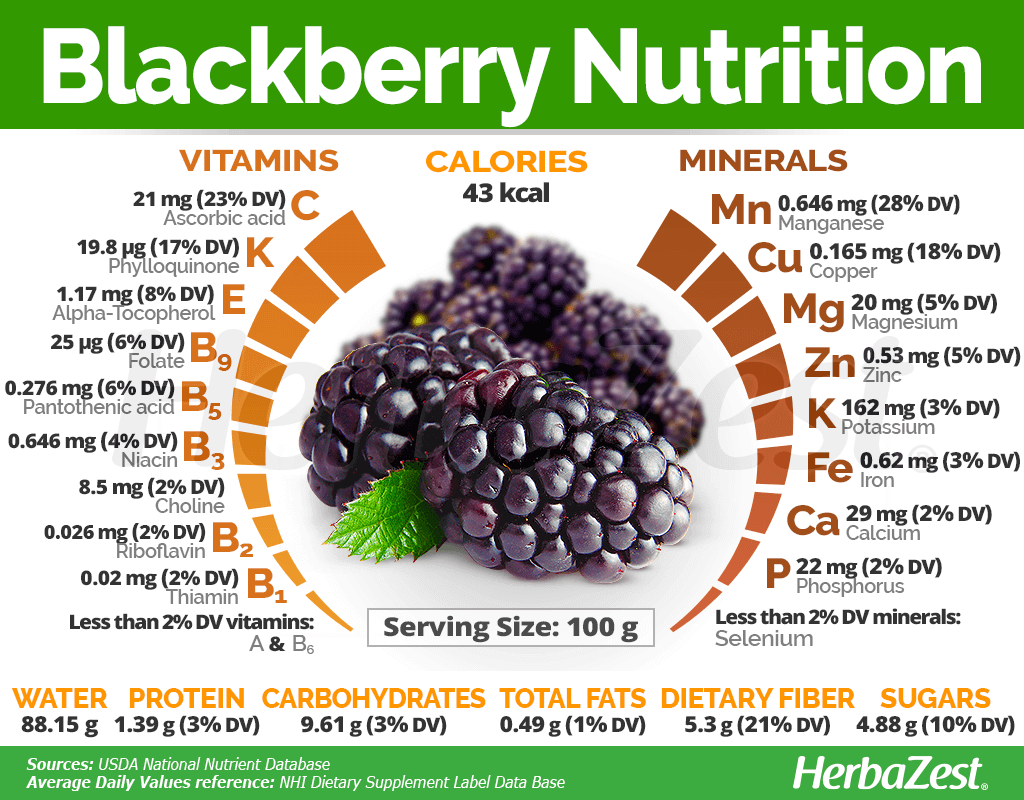
How to Consume Blackberry
For centuries, blackberries have been valued by many cultures as a way to enhance the flavor and smell of various meals. For medicinal purposes, however, blackberries can be taken as a supplement or as other herbal remedies.
Natural Forms
Raw. Although they are widely used as an ingredient in many cooked meals, blackberries are most commonly consumed raw. They can be used as a garnish or an addition to a variety of sweet and savory dishes.
Cooked. Blackberries are commonly used in jams, pies, and desserts due to their natural mild sweetness and versatility; however, they are also used to flavor alcoholic beverages, such as wine and brandy.
Juice. Fresh, frozen, or dried and powdered, blackberries can be made into juices and added to smoothies, both alone or mixed with other fruits.
- Powder. This popular form of consumption has a longer shelf-life, making it a great option for shakes and other beverages.
Herbal Remedies & Supplements
Liquid extract. This preparation concentrates natural properties of the herb. A few daily drops of the extract diluted in a glass of water can bring all the benefits of blackberries.
Capsules. The antioxidant power of blackberries can be obtained in standardized, daily doses.
- Edible parts Fruit
- Edible uses Flavoring, Coloring, Beverage
- Taste Sweet, Tart
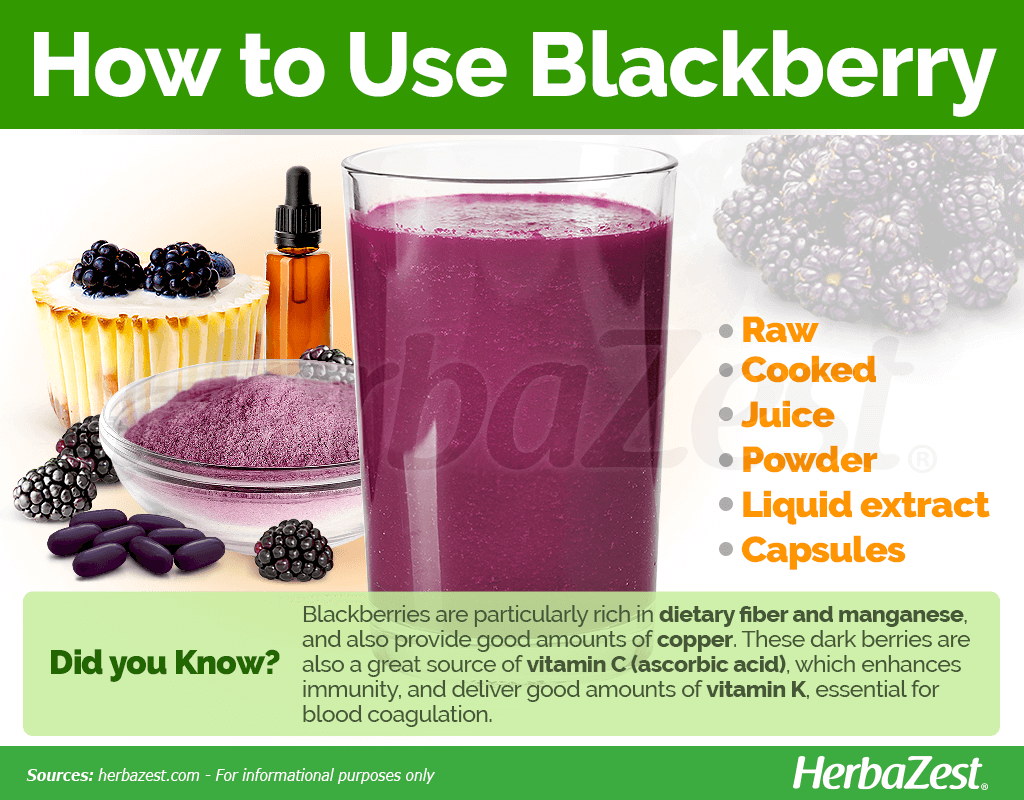
Growing
The blackberry tree or shrub is very adaptable to its surroundings, and grows wildly in many regions around the world. In fact, in some areas, it is even considered a weed. However, when it comes to commercial cultivars, it is important to consider the specific type of blackberry being grown.
Growing Guidelines
Erect blackberry shrubs require less spacing (as little as 10 feet, or about 3 m, between each shrub) but fairly regular formation pruning; semi-erect and trailing cultivars, on the other hand, will require 16 - 26 feet (approx. 5 - 8 m) between each plant in addition to training to conduct growth.
In order for a blackberry tree to reach its maximum potential, it should be planted in sandy, acidic soil in a spot which is exposed to full sun.
It is preferable for the soil to have a pH of 5.5 - 7.0. Deep watering will prevent soil from drying out.
The blackberry shrub prefers warm, temperate climates and is vulnerable to frosts.
The blackberry plant is also quite vulnerable to viral infestations, so it's strongly encouraged to keep plantations far away from wild blackberry shrubs.
- Life cycle Perennial
- Harvested parts Leaves, Fruit
- Light requirements Full sun
- Soil Light (sandy)
- Soil pH 5.6 – 6.0 (Moderately acidic), 6.1 – 6.5 (Slightly acidic), 6.6 – 7.3 (Neutral)
- Growing habitat Temperate climates, Warm climates
- Plant spacing average 3 m (9.84 ft)
- Potential diseases Viruses
Additional Information
Plant Biology
The blackberry tree or shrub is characterized by a torus that remains attached to the fruit, which is what differentiates it from raspberries, relatives in the same genus. Botanically, blackberry is not considered to be a true berry but an aggregated fruit. The leaves are three or five compound oval leaflets, and the white or pink flowers of the plant are 0.75 - 1.2 inches (2 - 3 cm) in diameter.
Classification
The blackberry plant (Rubus fruticosus) is a member of the Rosaceae family, which contains about 2,830 species spread out over 95 genera. Other well-known members of the Rosaceae family are almond (Prunus dulcis), apple (Malus domestica), hawthorn (Crataegus monogyna), pear (Pyrus communis), prune (Prunus domestica), and strawberry (Fragaria x ananassa).
Blackberry is also a member of the genus Rubus, which comprises a wide variety of deciduous shrubs. It includes 12 recognized subgenera, many of which have hundreds of species. Raspberry (Rubus idaeus) and blackberry (Rubus fruticosus), are among the most popular species of Rubus cultivated for their edible berries. On the other hand, Rubus coreanus and Rubus hirsutus are mostly used in Chinese Traditional Medicine, while Rubus ursinus has been traditionally consumed by Native Americans to treat swellings and sores.
Varieties and Cultivars of Blackberry
For millennia, blackberry has grown wild around the world and dozens of varieties have appeared naturally. As a result, there are many types of blackberries nowadays.
Because of the blackberry's ability to crossbreed with ease, there are numerous cultivars that have been created and introduced for commercial and amateur cultivation, both in Europe and in the United States, such as the long-standing 'Brazos' and 'Cherokee', or the newer 'Black Satin' variety. Prickle-free cultivars, which facilitate processing of the fruit, have been developed throughout the world, including the 'Black Diamond' and 'Nightfall' cultivars.
Popularly consumed hybrids of raspberry and blackberry are 'Loganberry', 'Boysenberry', and 'Tayberry.'
Historical Information
The blackberry plant is an ancient species that has existed for over 30 million years. It is unclear whether it originated in Asia, Europe, North America, or South America. However, it is known that Ancient Greeks used the blackberry fruit to alleviate the symptoms of gout, while the Romans favored the leaves to treat various ailments. Egyptians used the berries as hair dye, while Native Americans used it as food, medicine, wine making, and to dye animal skins.
Economic Data
Mexico is currently the biggest producer of blackberries, with most of their produce being exported to North America and Europe during the off-season.
Oregon is the biggest blackberry-producing state in the United States, with over 56.1 million pounds (25.4 million kg) of blackberries cultivated over 7,000 acres in 2009. The United Kingdom, Chile, and New Zealand are also its producers.
Blackberries crossbreed with each other easily, so many have been artificially cultivated to increase their yield and value.
Other Uses
Dye. Historically, the berries have been used as a dye for both hair and materials.
Wine. The blackberry vines and twigs have been historically used as flavoring agents in the wine industry.
Cosmetics. Extracts of blackberry are also added to some cosmetics for color or aroma.
- Other uses Cosmetics, Dye
Sources
- Encyclopedia of Cultivated Plants: From Acacia to Zinnia, p. 150
- European Journal of Nutrition, Neuroprotective effects of digested polyphenols from wild blackberry species, 2013
- Oregon State University, Growing Blackberries in Your Home Garden
- The British Journal of Nutrition, The impact of fruit flavonoids on memory and cognition, 2010
- The New Healing Herbs, pp. 100 - 101
- USDA Plants Database, Oregon Berry Production ; Thornless Processing Blackberry Cultivars
- Encyclopedia of Herbal Medicine, p. 263
- Journal of Medicinal Food, Characterization of Blackberry Extract and Its Antiproliferative and Anti-Inflammatory Properties, 2007
- Medicinal Plants of the World, p. 277
- American Journal of Clinical Nutrition, Content of redox-active compounds (ie, antioxidants) in foods consumed in the United States, 2006
- Journal of Agricultural and Food Chemistry, Phenolic compounds and antioxidant capacity of Georgia-grown blueberries and blackberries, 2002
- Pharmacognosy Reviews, Rubus fruticosus (blackberry) use as an herbal medicine, 2014
